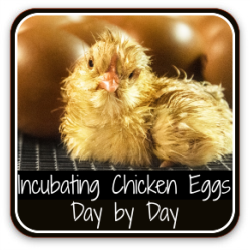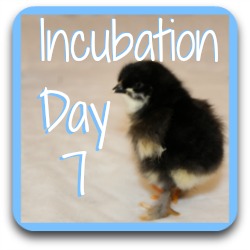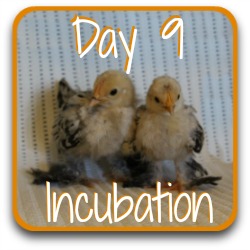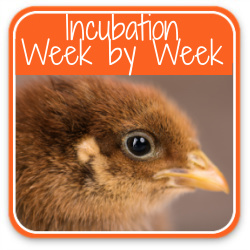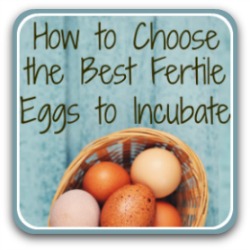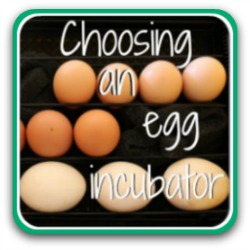- Home
- Incubation day by day
- Day 8
Incubation of chicken eggs: what's happening at day 8?
It's the start of week 2 of incubation. The embryo has already come a long way, from a collection of cells at day 1 to a developed being with microscopically recognisable parts by day 8.
At this stage the embryo is still quite fragile though, and it's important we maintain as close to ideal conditions as possible to safeguard its continued development.
Here's what's happening at Day 8 in the incubation of chicken eggs, and what we need to do to continue towards a successful hatch.
What's going on in the egg today?
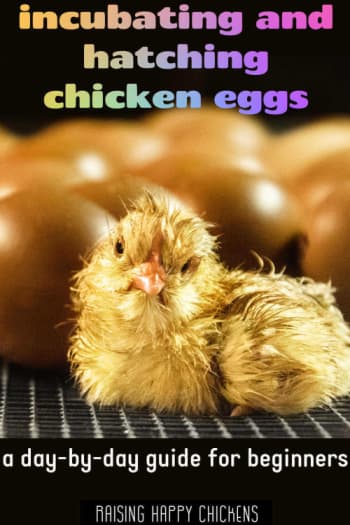
* There's massive development during the second week in the life of a chicken embryo – it's the most exciting stage of incubation.
* In candling, we can see more than during week one. By week three the chick is filling the egg so we'll be able to see very little.
* Between now and the end of this week the embryo will become more and more like a baby bird and will turn to make sure it's facing the right way for hatching.
* If we opened the egg today we'd be able clearly to see the yolk, a complex system of blood vessels, and the embryo's eyes, which at this stage look massively out of proportion to the rest of the chick.
* The air cell continues to grow at the blunt end of the incubated egg.
What's happening to the chick at this stage in the incubation of chicken eggs?
- The most obvious part of a chicken embryo at day 8 is the eye. As well as the eye itself growing (and looking far too large for the growing chick!) the third eyelid, or nictating membrane, is growing.
- This is a transparent membrane which keeps the eye moist and free from grit by moving across the eye – not up and down like the upper and lower eyelids.
- It's clear so that the chicken can keep an eye open – literally – for predators, even as it blinks.
Please note: the image below is a commissioned piece and is subject to international copyright laws. I am the sole copyright owner.
It must not be used, copied or reproduced anywhere without my permission.
Contact me for details and permissions for this and all other images on this page.
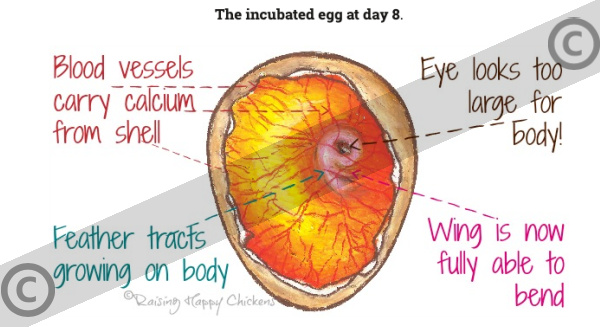
- The chick's ears have now started to form as distinct structures for the first time.
- Limb buds, where the chick's legs and wings will form, are now visible under a microscope.
- The pterylae or feather tracts – the part of the chicken's body from which the feathers sprout – are developing today.
- The fluffy down the chick will be born with, known as natal down, is growing. This down will be very wet at hatch, and the chicks will need to dry out in their incubator.
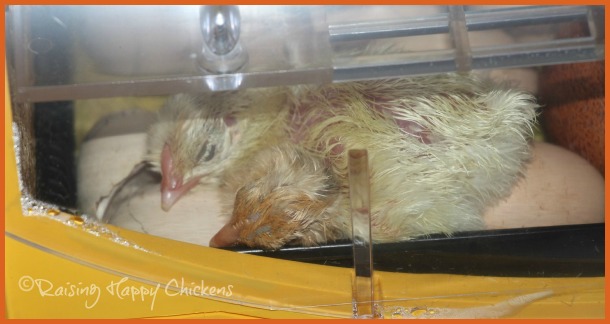 Two of my Wyandotte chicks drying their down in the incubator.
Two of my Wyandotte chicks drying their down in the incubator.- The skeleton is developing and hardening as the blood vessels provide calcium taken from the shell. In particular, the thigh bones start to fill with marrow.
- It's for this reason that it is so important to choose eggs for incubating which are in the best condition, from hens which have been supplied with the correct amounts of calcium.
How to make sure your laying hens have enough calcium.
It's critically important that, if you intend to use your own eggs to incubate, your hens have enough calcium to make sure their eggshells are strong.
As the embryo develops, calcium is taken from the shell. If the shell is lacking in calcium, problems with the chicks' development are inevitable.
Find out here how to make sure your flock has the calcium it needs.
Incubation of chicken eggs: what will candling show?
Candling at day 8 shows a rapidly growing embryo, with its blood vessels becoming more dense and complex in order to sustain its growing needs.
The air cell continues to grow and is clearly visible at the blunt end of the egg.
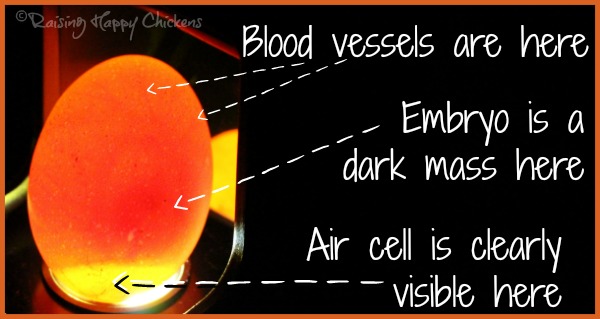
Below is exactly the same picture but with the colour and saturation levels changed. Now the 'hot spots' of the embryo and blood vessels are much easier to see.
The growing embryo still lies on top of the yolk and is excitingly obvious, curled into its 'C' position.
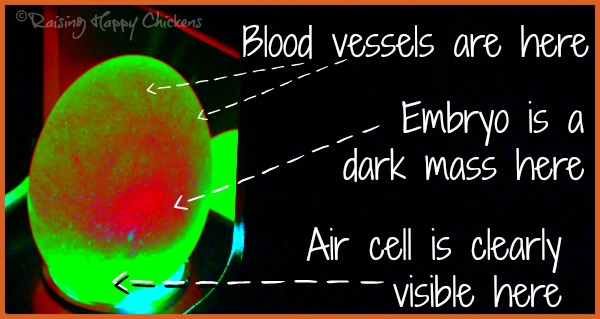
What should we be doing today?
- If you haven't yet candled your eggs you may want to do so now. By day 8, there will usually be signs of development, but even if there are not don't discard the egg. Wait until day 10 and candle again.
- If you are lucky enough to be using a broody hen you may not want to candle at all. Broodies are extremely protective of their eggs and getting them out and back again can be fraught with difficulty!
- If you candle, be aware that the incubated egg shells will be increasingly porous. Bear in mind the need for good hygiene.
- Wash your hands, or use a hand sanitiser before you candle each egg. Otherwise, you run the risk of transmitting bacteria to the embryo, which will be fatal.
Incubation of chicken eggs: question of the day.
What will I see if I candle today and there's no development?
- When an egg's not developing, there will be no sign of a darker area (the embryo) or its system of blood vessels.
- There will be a darker area, which is the yolk, but nothing inside it.
- The egg below was from a Wyandotte hen, but at day 8 is showing no signs of development.
- The increasingly porous nature of the shell is clear in this image: look for the light areas throughout the shell.
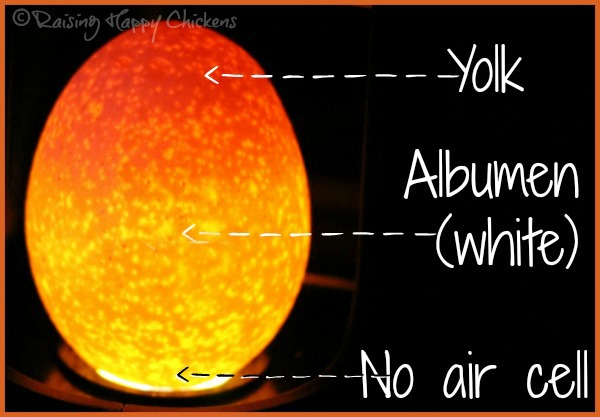
Should I discard eggs that are not developing at day 8?
If the egg is showing any signs of oozing, or smells bad, discard it immediately. It will be in danger of exploding and scattering bacteria over the other incubated eggs.
Otherwise, this is a personal call.
Some chicks take longer than others to develop and some, particularly those like Marans which have a very dark shell, are just too hard to see.
The egg in the picture above didn't develop and was discarded at day 14 which is the longest I would advise leaving an incubated egg which is showing no signs of developing.
It's never an easy thing to do, but if left any longer, there's a danger the shell as it becomes more porous will take in bacteria and contaminate all the others.
Incubation of chicken eggs: where to next?
To return to the beginning of this series, click the first button link. For yesterday's detailed information, use the second button; if you're ready to progress to day 8, it's the third button you need.
More information about incubating chicken eggs.
Sources.
A lot of "facts" you'll find on the internet are often people's individual views, based on inaccurate information repeated from poor quality sources.
The information I provide in this article and others is based on both my own experience of incubating and hatching chicken eggs every year for over 13 years, but on evidenced facts from scientific, peer-reviewed research and books from highly respected and experienced poultry keepers such as Gail Damerow.
Some of the trusted sources I have used in this article are these.
Avitronics: Heart Rates. Pub. Avian ID, 2020.
Damerow, Gail: Hatching and Brooding Your Own Chicks. Pub. Storey, 2013. See my review, here.
Hall, C., et al: A new candling procedure for thick and opaque eggs and its application to avian conservation management. Pub. Journal of Zoobiology, 2022.
Hamburger, V and Hamilton, H L: A series of normal stages in the development of the chick embryo. Pub. Journal of Morphology, 1951.
Leonor, H., and Chaveiro, S: The Effect of Candling on the Hatchability of Eggs from Broiler Breeder Hens. Pub. Journal of Applied Poultry Research, 1993.
Phuphanin, A., et al: Smartphone-Based Device for Non-Invasive Heart-Rate Measurement of Chicken Embryos. Pub. National Center for Biotechnology Information, 2019.
Vargas, R., et al: Egg Candling Analysis Equipment Design: A Safety Solution. Pub. Journal of Social and Behavioural Sciences, 2018.
Wu et al: Egg fertility and reduced egg fertility, hatching success, and larval survival. Pub. Science Direct, 2003.
- Home
- Incubation day by day
- Day 8
